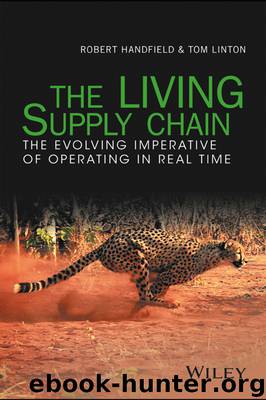The LIVING Supply Chain by Handfield Robert; Linton Tom;

Author:Handfield, Robert; Linton, Tom; [Handfield Robert]
Language: eng
Format: epub
ISBN: 9781119307228
Publisher: John Wiley & Sons, Incorporated
Published: 2017-05-31T00:00:00+00:00
Speeding Up the Flow of Cash in the Pipeline: Procure-to-Pay Systems
Tom sees many of today's systems designed to deal with financial accountability as not only cumbersome, but often creating more complexity that in the end reduces transaction visibility and flow. This further muddies the waters and works against financial transparency and hence accountability. Purchase orders are one of the biggest elements of friction today.
“Purchasing is simply too transactional,” Tom said. “The cycle of procurement requires a tedious process, beginning with a requisition, an approval, a purchase order, an invoice, and finally a payment. Organizations can't seem to conduct a commercial transaction without some kind of a purchase order every single time. But what has happened is that we have created a proliferation of purchase orders for every single order, and because the volume has escalated, organizations have once again used labor arbitrage to move their PO processing to China or India. And an entire industry has sprung up around processing POs, which is a non-value-added function!”
In a recent interview, an executive working in a major electronics company emphasized that its systems were creating massive problems for them – and driving the exact opposite effect of asset velocity. On the customer end, the company had millions of dollars of orders that had already been delivered to its customers in Brazil, but the ERP system they invested in was unable to generate the invoices in a format that complied with Brazil's regulatory requirements. As a result, customers were unable to pay the company, as doing so would violate the law. The company had orders that had been delivered six months earlier, but had not yet been paid for, or even invoiced properly. On the supplier end, purchase order systems were so completely dysfunctional that several suppliers of common items like utilities, contract manufacturing, and other services had stopped performing against their contractual obligations until they were paid, thereby halting operations and further delaying deliveries to customers. What a nightmare! The company was effectively shrinking its assets, both on the customer and the supplier ends, due to a transactional systems issue.
In general, disparate ERP systems create friction, which in turn slows down the flow of material and information in the supply chain. Data transparency creates instantaneous knowledge and understanding of what is happening. As in the laws of thermodynamics, the fewer obstacles in the path of flow, the faster the flow. The new rules of supply chain advocate moving faster and this is accomplished by improving flow and reducing friction.
Another example of how typical supply chain processes can slow us down is the proliferation of just-in-time and kanban production systems. The original intention of these systems was to reduce inventory through multiple deliveries by suppliers in small quantities. This method worked well in places like Japan, where suppliers are located near the production facility. But in a country like the United States, or in global supply networks, it is doing enormous harm to the environment and is complicating transportation networks. There are more trucks, more deliveries, and more boxes.
Download
This site does not store any files on its server. We only index and link to content provided by other sites. Please contact the content providers to delete copyright contents if any and email us, we'll remove relevant links or contents immediately.
Hit Refresh by Satya Nadella(8338)
The Compound Effect by Darren Hardy(7559)
Change Your Questions, Change Your Life by Marilee Adams(6641)
Nudge - Improving Decisions about Health, Wealth, and Happiness by Thaler Sunstein(6633)
The Black Swan by Nassim Nicholas Taleb(6191)
Daring Greatly by Brene Brown(5641)
Deep Work by Cal Newport(5464)
Principles: Life and Work by Ray Dalio(5322)
Rich Dad Poor Dad by Robert T. Kiyosaki(5149)
The Myth of the Strong Leader by Archie Brown(4789)
Man-made Catastrophes and Risk Information Concealment by Dmitry Chernov & Didier Sornette(4736)
Big Magic: Creative Living Beyond Fear by Elizabeth Gilbert(4723)
The Slight Edge by Jeff Olson(4722)
Discipline Equals Freedom by Jocko Willink(4635)
Digital Minimalism by Cal Newport;(4542)
The Motivation Myth by Jeff Haden(4526)
Stone's Rules by Roger Stone(4415)
Management Strategies for the Cloud Revolution: How Cloud Computing Is Transforming Business and Why You Can't Afford to Be Left Behind by Charles Babcock(4131)
The Doodle Revolution by Sunni Brown(4043)
